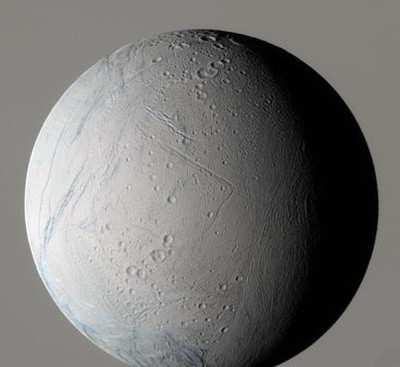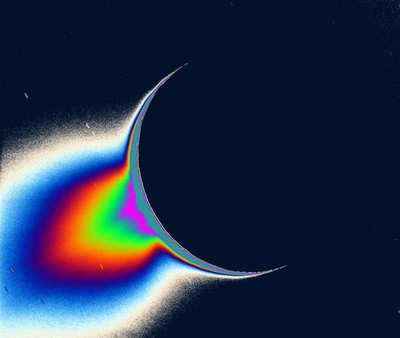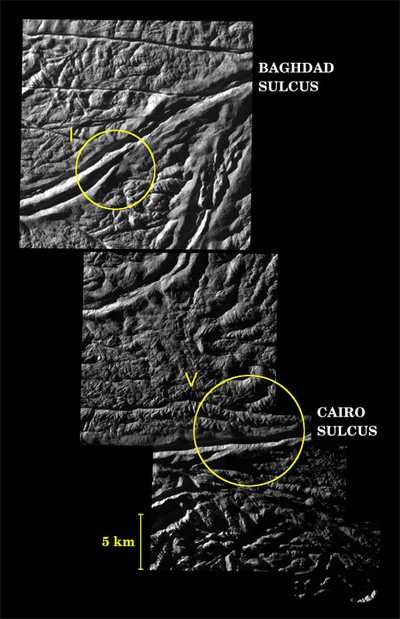Enceladus Puts On A Show For Cassini Probe
The closer scientists look at Saturn's small moon Enceladus, the
more they find evidence of an active world, according to a NASA
update.

The most recent flybys of Enceladus made by the agency's Cassini
spacecraft have provided new signs of ongoing changes on and around
the moon. The latest high-resolution images of Enceladus show signs
that the south polar surface changes over time.
Close views of the southern polar region, where jets of water
vapor and icy particles spew from vents within the moon's
distinctive "tiger stripe" fractures, provide surprising evidence
of Earth-like tectonics. They yield new insight into what may be
happening within the fractures. The latest data on the plume -- the
huge cloud of vapor and particles fed by the jets that extend into
space -- show it varies over time and has a far-reaching effect on
Saturn's magnetosphere.
"Of all the geologic provinces in the Saturn system that Cassini
has explored, none has been more thrilling or carries greater
implications than the region at the southernmost portion of
Enceladus," said Carolyn Porco, Cassini imaging team leader at the
Space Science Institute in Boulder, CO.
A panel of Cassini scientists, including Porco, presented these
new findings Monday in a news briefing at the American
Geophysical Union's fall meeting in San Francisco.

"Enceladus has Earth-like spreading of the icy crust, but with
an exotic difference -- the spreading is almost all in one
direction, like a conveyor belt," said panelist Paul Helfenstein,
Cassini imaging associate at Cornell University in Ithaca, N.Y.
"Asymmetric spreading like this is unusual on Earth and not well
understood."
"Enceladus has asymmetric spreading on steroids," Helfenstein
added. "We are not certain about the geological mechanisms that
control the spreading, but we see patterns of divergence and
mountain-building similar to what we see on Earth, which suggests
that subsurface heat and convection are involved."
The tiger stripes are analogous to the mid-ocean ridges on
Earth's seafloor where volcanic material wells up and creates new
crust. Using Cassini-based digital maps of the south polar region
of Enceladus, Helfenstein reconstructed a possible history of the
tiger stripes by working backward in time and progressively
snipping away older and older sections of the map. Each time he
found that the remaining sections fit together like puzzle
pieces.

Images from recent close Enceladus flybys also have bolstered an
idea the Cassini imaging team has that condensation from the jets
erupting from the surface may create ice plugs that close off old
vents and force new vents to open. The opening and clogging of
vents also corresponds with measurements indicating the plume
varies from month to month and year to year.
"We see no obvious distinguishing markings on the surface in the
immediate vicinity of each jet source, which suggests that the
vents may open and close and thus migrate up and down the fractures
over time," Porco said. "Over time, the particles that rain down
onto the surface from the jets may form a continuous blanket of
snow along a fracture."
Enceladus' output of ice and vapor dramatically impacts the
entire Saturnian system by supplying the ring system with fresh
material and loading ionized gas from water vapor into Saturn's
magnetosphere.
"The ions added to the magnetosphere are spun up from Enceladus'
orbital speed to the rotational speed of Saturn," said Cassini
magnetometer science team member Christopher Russell of the
University of California, Los Angeles. "The more material is added
by the plume, the harder this is for Saturn to do, and the longer
it takes to accelerate the new material."
With water vapor, organic compounds and excess heat emerging
from Enceladus' south polar terrain, scientists are intrigued by
the possibility of a liquid-water-rich habitable zone beneath the
moon's south pole.

Cassini's flybys on August 11 and October 31 of this year
targeted Enceladus' fractured southern region. An October 9 flyby
took the spacecraft deep into the plume of water vapor and ice
shooting out of the moon's vents. Cassini's next flyby of Enceladus
will be in November 2009.
 Airbus Racer Helicopter Demonstrator First Flight Part of Clean Sky 2 Initiative
Airbus Racer Helicopter Demonstrator First Flight Part of Clean Sky 2 Initiative Diamond's Electric DA40 Finds Fans at Dübendorf
Diamond's Electric DA40 Finds Fans at Dübendorf ANN's Daily Aero-Term (04.23.24): Line Up And Wait (LUAW)
ANN's Daily Aero-Term (04.23.24): Line Up And Wait (LUAW) NTSB Final Report: Extra Flugzeugbau GMBH EA300/L
NTSB Final Report: Extra Flugzeugbau GMBH EA300/L Classic Aero-TV: 'Never Give Up' - Advice From Two of FedEx's Female Captains
Classic Aero-TV: 'Never Give Up' - Advice From Two of FedEx's Female Captains






